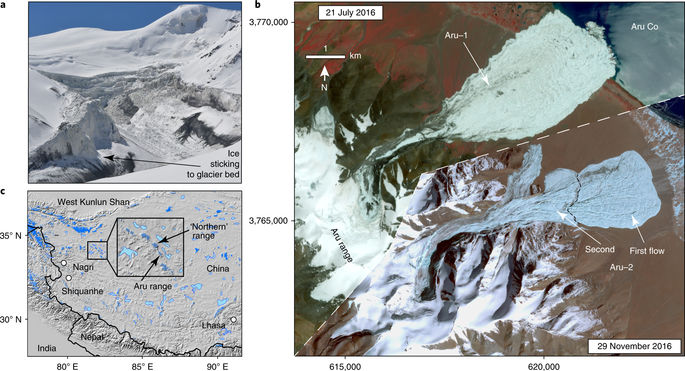Nature Geoscience ( IF 15.7 ) Pub Date : 2018-01-22 , DOI: 10.1038/s41561-017-0039-7 Andreas Kääb , Silvan Leinss , Adrien Gilbert , Yves Bühler , Simon Gascoin , Stephen G. Evans , Perry Bartelt , Etienne Berthier , Fanny Brun , Wei-An Chao , Daniel Farinotti , Florent Gimbert , Wanqin Guo , Christian Huggel , Jeffrey S. Kargel , Gregory J. Leonard , Lide Tian , Désirée Treichler , Tandong Yao

|
Surges and glacier avalanches are expressions of glacier instability, and among the most dramatic phenomena in the mountain cryosphere. Until now, the catastrophic collapse of a glacier, combining the large volume of surges and mobility of ice avalanches, has been reported only for the 2002 130 × 106 m3 detachment of Kolka Glacier (Caucasus Mountains), which has been considered a globally singular event. Here, we report on the similar detachment of the entire lower parts of two adjacent glaciers in western Tibet in July and September 2016, leading to an unprecedented pair of giant low-angle ice avalanches with volumes of 68 ± 2 × 106 m3 and 83 ± 2 × 106 m3. On the basis of satellite remote sensing, numerical modelling and field investigations, we find that the twin collapses were caused by climate- and weather-driven external forcing, acting on specific polythermal and soft-bed glacier properties. These factors converged to produce surge-like enhancement of driving stresses and massively reduced basal friction connected to subglacial water and fine-grained bed lithology, to eventually exceed collapse thresholds in resisting forces of the tongues frozen to their bed. Our findings show that large catastrophic instabilities of low-angle glaciers can happen under rare circumstances without historical precedent.










































 京公网安备 11010802027423号
京公网安备 11010802027423号